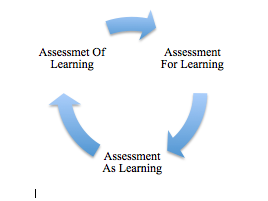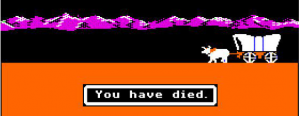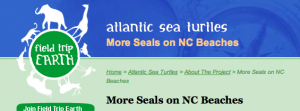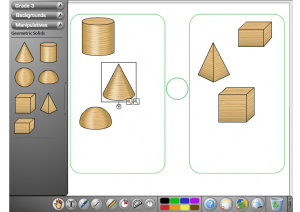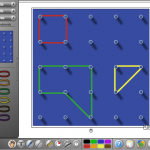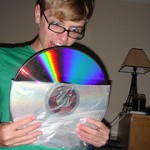Technology For, As, and Of Learning
Assessment for, as, and of learning, is a phrase often heard and discussed in and by the educational community. Assessment for, as, and of learning, is a continuous circle of learning (Earl, 2006).
Arising from the learning facilitated by the many MET courses that I have taken to date and synthesized, crafted, and enhanced during the activities, challenges, and e-folio reflections of ETEC 533 (Technology in the Mathematics and Science Classroom) is a personal model of technology inclusion applicable to both students and educators. Similar to the model of assessment, this technology model too is circular.
 ETEC 533 was my final Masters of Educational Technology (MET) course. In one of my first ETEC 533 blogs (Flick, 2012), I introduced myself as a learner. A learner whose path had led to the study of and in a masters of educational technology.
ETEC 533 was my final Masters of Educational Technology (MET) course. In one of my first ETEC 533 blogs (Flick, 2012), I introduced myself as a learner. A learner whose path had led to the study of and in a masters of educational technology.
Prior to MET, I completed a Masters of curriculum and instruction. That Masters culminated in a thesis on teacher math anxiety. Professionally speaking, math is my first passion. My current work is to support teacher and student mathematical understanding and improved mathematical practice. I facilitate teacher mathematical understanding which in turn improves student success. MET has kindled a similar passion for me in the area of technology and ETEC 533 has caused me to consider and implement practice that will combine the two.
I turned fifty shortly after beginning MET. I was a technology user. Email, word processing, the Internet, and power points were part of my personal and professional life. Decades of technology use found me using technology to acquire and distribute information (Flick, 2012). My first MET course found me overwhelmed by the technological requirements and uncertain of my capabilities. I recall suffering from posting anxiety. I was ill equipped to create and to demonstrate learning using digital and social media tools. Since then both have become a tool. Technology and social media are no longer just a means by which to gather and share information. They are now tools with which I can create and demonstrate. They are now tools that I can use with purpose.
I was a technology user. Email, word processing, the Internet, and power points were part of my personal and professional life. Decades of technology use found me using technology to acquire and distribute information (Flick, 2012). My first MET course found me overwhelmed by the technological requirements and uncertain of my capabilities. I recall suffering from posting anxiety. I was ill equipped to create and to demonstrate learning using digital and social media tools. Since then both have become a tool. Technology and social media are no longer just a means by which to gather and share information. They are now tools with which I can create and demonstrate. They are now tools that I can use with purpose.
During ETEC 533 I have been able to reflect upon my journey as a technology learner. I have been able to share in discussion as others have similarly reflected in their Auto e-ographies. I have had the opportunity to research teachers as technology learners in my Framing Issues Assignment. Reflection and research have led me to the idea of technology for, as, and of learning. Well crafted activities have allowed me to consider my strongest area of practice, mathematics, within the possibilities of technology tools, resources, and pedagogy.
Technology For Learning
Technology for learning is educators using technology to connect with other professionals to improve practice. Technology can enable educators to engage in learning communities locally (the classroom next door) and globally (Alberta, Mexico, Jamaica). As a classroom teacher I often felt isolated from colleagues within my schoolhouse and within my district. During my terms in the MET program that sense of isolation has diminished. It has diminished because learning communities have formed. Some learning communities have lasted for an assignment, many for the duration of a course, a few for the entirety of my MET studies, and a precious few will continue beyond MET graduation.
In Module A, as I began to Unpack Assumptions, I wrote of the collaborative possibilities. “Perhaps the greatest effect of technology in the math and science class might be the collaboration, learning and support that are now offered every teacher. Wikis, Blogs, List Serves, Moodles, make it possible for every teacher to work not in isolation but as part of a learning community.” (Flick, 2012)
Where else will the power of technology for learning lie? “Ultimately, the effectiveness of educational technology, be it in whatever form, is determined by whose hands it’s in and whether they can unlock its potential” (Braidwood, 2012). In the same post, Braidwood continues on to speak of technology being well used for learner engagement, enrichment of learning experiences, differentiation and diversification and to extend learning beyond the four walls of the classroom. The power of technology for learning may be in its capacity to connect learners (students and/or educators) across distances. This cohort experienced this capacity as educators were connected in the Module A Video Cases. Educators were connected and learning environments were analyzed.
Jonassen (2000), does not believe that students learn from computers or teachers but rather from opportunities to think. The educator is necessary to technology for learning. This belief was also supported by Samia Khan in a synthesis of our Module B syntheses “ . . . the role of the teacher as being critical in the design of the entire learning experience.” (Khan, 2012)
Technology As Learning
Technology as learning are the uses of technology that share content, experiences, process. Here the resource/technology must be analyzed through the lens of developmental learning theory and pedagogy, (Kozma, 2003). The theories of learning applied to Technology Enhanced Learning Environments (TELE) are a splendid example of technology as learning. Module B organized the activities and our reflections to have us consider technology as not the tools of our trade but as a way of acting, (Muffoletto, 1994).
In Module B the technologies that we investigated, WISE, Jasper, My World, and Chemland were specific. The purpose of the activities was to develop our pedagogical sense and apply it to potential technologies that might be used in our classrooms. As well, we began to envision technology as a tool much greater than that of engagement or communication. Whyte (2012), shared “I only viewed it as an alternative medium to improve engagement, never as a tool to help students develop higher order thinking skills or to improve their ability to function effectively in the world beyond the classroom” (Means, 1997).
Module B was a grand opportunity to investigate math and science resources past and present that could be employed to provide content, activities, and experiences. All resources shared by the facilitators of this course “blended different pedagogical models with social constructivism” (Virk, 2012). Module C, Info-Vis Forum, was where the cohort shared the expanse of opportunities for teachers and students to employ technology in the math and science classroom. From the simplest of counting skills 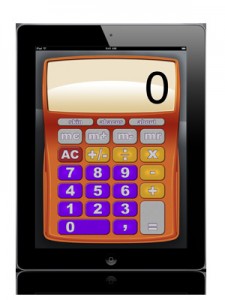 to the use of graphing calculators, lessons to enhance learning while employing technology were shared.
to the use of graphing calculators, lessons to enhance learning while employing technology were shared.
Technology Of Learning
Technology of learning are the demonstrations of learning from student and/or teacher. Technology of learning are the products of process, creation, learning, synthesis. ” I am able to let the students cover the learning outcomes using material that they are interested in, with presentation styles that suit them . . . it has allowed me to expand my portfolio of acceptable demonstrations of student knowledge.” (JB, 2012)
Technology of learning ensures that demonstrations of learning can be differentiated. It ensures that learning disabilities need not interfere with a learner’s ability to demonstrate understanding. It ensures that proof of learning and growth need not be hindered by many challenges (written output, spatial, speech . . .).
For myself, technology of learning has resulted in a Blog, Wiki, Digital Story,and Moodle. It has also resulted in discussion forums and google docs. Products of learning that have been created through collaboration of individuals who are separated by great distance and may likely never meet. Products of learning of which one may have created and later another enhanced. Products of learning that exceed the expectations and capabilities of the individual and result from the strengths of two or more learners coming together.
Conclusion
During the postings and responses and in the Module A Interviews, the conversations and questions occasionally themed around the challenge to technology use in classrooms and teacher reluctance. Among the themes that emerged were lack of time for teachers to learn to operate, investigate, and plan to incorporate technology into their teaching days. “I don’t often have enough time to learn how to use technology in the class, …sometimes, the equipment fails” (Chen, 2012). Also lamented was the lack of technology professional development and/or effectiveness of professional development. Many interviewees shared concern for continued financial and technological support once equipment was installed in their schools and classrooms. Change fatigue and technology as a threat were issues raised by those interviewed in Rapid change – individualized learning – reliability, (Evans, 2012). Comfort in textbooks and technology necessitating the need for educators to examine practice were mentioned.
My Framing Issues Assignment provided the opportunity for me to investigate effective and ineffective methods to promote purposeful technology use in the math and science classroom. I questioned whether I could identify the reasons why some teachers were technologically competent and continued to be learners in this area and why some were not. Surely we all experience the obstacles to technology usage shared above, yet some of us have still worked through, around, over, those barriers and technology is present in our classrooms and employed by both teacher and student.
I considered my colleague, JB, who had been the focus of our interview assignment. JB had “thirty plus years of teaching experience” and was “self-motivated to learn to use technology and to purposefully incorporate technology into her classroom” (Flick, 2012) Why? I wondered what the connection might be between personal and professional use of technology. I wondered what type of professional development opportunities had the most affect on teacher incorporation of technology?
Interestingly, my findings in some ways paralleled my findings when investigating teacher math anxiety. Teaching teachers how to teach math has little affect. Providing opportunities for teachers to develop mathematical understanding does.Teacher mathematical understanding is imperative to effective mathematics instruction. It is challenging to be a teacher of mathematics if one does not embrace mathematics personally.
Is the same true for technology? Will only those for whom technology is a personal tool choose to use technology as an educational tool? What effect does professional development have on technology usuage?
Teachers who employ technology in their classrooms and who provide opportunities for their students to do so:
•are personal users of technology
•are given opportunities to learn with technology
•are given opportunities to demonstrate their learning with technology
•collaborate or are mentored by others who use technology
References
Braidwood, J. (2012, April 12). Measuring good [Online forum comment].
Chen, D. (2012, January 22). Support for teachers [Online forum comment].
Dalgarno, N., & Colgan, L. (2007). Supporting novice elementary mathematics teachers’ induction in professional communities and providing innovative forms of pedagogical content knowledge development through information and communication technology. Teaching and Teacher Education, 23, 1051 – 1065. Retrieved from http://teaching.cycu.edu.tw/pdf/
Earl, L. M. (2006). Rethinking classroom assessment with purpose in mind. Manitoba Education, Citizenship & Youth, 2006.
Evans, V. (2012, January 17). Rapid change – individualized learning – reliability [Online forum comment].
Flick, D. (2012, January 8). Hello ETEC 533! [Web log message]. Retrieved from https://blogs.ubc.ca/deniseflick533/2012/01/08/hello-world/
Flick, D. (2012, January 8 ) A high school infatuation? An auto e-ography. [Web log message]. Retrieved from https://blogs.ubc.ca/deniseflick533/2012/01/08/a-highschool-infatuation/
Flick, D. (2012, January 22). Technology interview transcript and analysis [Web log message]. https://blogs.ubc.ca/deniseflick533/2012/01/22/technology-interview-transcript-and-analysis/
Jonassen, D. H. (2000). Computers as mindtools for schools, 2nd Ed. Upper Saddle River, NJ: Merrill/ Prentice Hall. Retrieved from Google Scholar: http://scholar.google.com/scholar?q=Jonassen+mindtools&ie=UTF-8&oe=UTF-8&hl=en&btnG=Search
Khan, S. (2012, February 28). Pedagogy [Online forum comment].
Kozma, R. B. (2003). Technology and classroom practices: An international study. Journal of Research on Technology in Education, 36(1), pp. 1-14.
Muffoletto, R. (1994). Technology and restructuring education: Constructing a context. Educational Technology, 34(2), 24-28.
Virk, J. (2012, February 26). Ways to weave effective technology into effective technology [Online forum comment].
Whyte, T. (2012, February 27). Jasper, wise, myworld, chemland and myway [Online forum comment].
